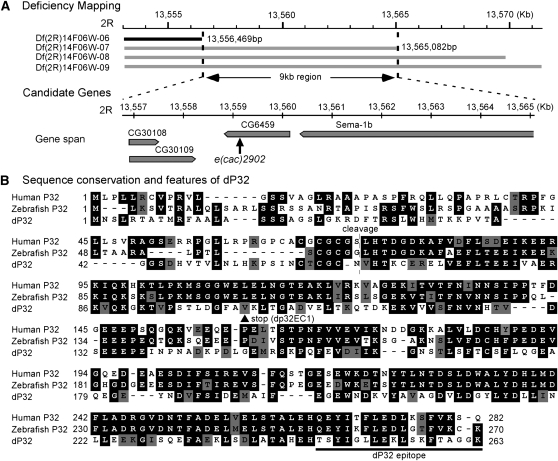Figure 3 .
A Drosophila P32 mutant. (A) Meiotic and deficiency mapping placed the e(cac)2902 mutation within a 9 kb region on the right arm of the 2nd chromosome (2R). Numerical positions (in kb or bp) within the Drosophila genome sequence are indicated. The deleted region for each deficiency chromosome is represented by a black or gray bar. Gray indicates that the deficiency chromosome failed to complement the e(cac)2902 behavioral phenotype when in trans to the e(cac)2902 mutant chromosome. Sequencing of four candidate genes within the 9 kb region revealed a single nucleotide deletion in the CG6459 ORF resulting in a premature stop codon. C at position 303 was deleted, and thus the resulting codon changes are from [GCC GTA A] to [GCG TAA] (deleted nucleotide underlined; new stop codon in bold). CG6459 is a Drosophila homolog of P32, and e(cac)2902 is now termed dp32EC1. (B) Alignment of P32 homologs from human, zebrafish, and Drosophila. Amino acid identities and similarities are shaded in black and gray, respectively. The dp32EC1 mutation introduces a premature stop codon (V102STOP; arrow head). Human P32 is synthesized as a precursor protein, of which the first 73 amino acids contain a mitochondrial targeting signal (Honoré et al. 1993). The mature protein is generated by site-specific cleavage after Residue 73 (broken line). The epitope for production of polyclonal antisera against dP32 is indicated (solid line). Amino acids are numbered according to their positions in the corresponding precursor proteins. Protein sequence accession numbers: human P32 (NP_001203), zebrafish P32 (XP_001331129) and dP32 (AAM11163).

